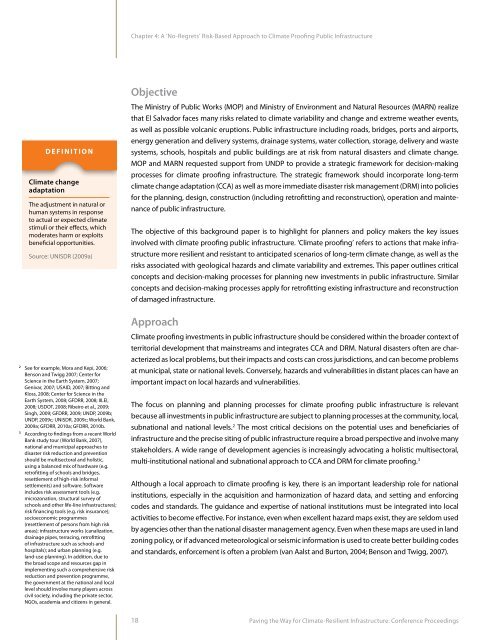Paving the Way for Climate-Resilient Infrastructure - UN CC:Learn
Paving the Way for Climate-Resilient Infrastructure - UN CC:Learn
Paving the Way for Climate-Resilient Infrastructure - UN CC:Learn
Create successful ePaper yourself
Turn your PDF publications into a flip-book with our unique Google optimized e-Paper software.
Chapter 4: A ‘No-Regrets’ Risk-Based Approach to <strong>Climate</strong> Proofing Public <strong>Infrastructure</strong>ObjectiveD E F I N I T I O N<strong>Climate</strong> changeadaptationThe adjustment in natural orhuman systems in responseto actual or expected climatestimuli or <strong>the</strong>ir effects, whichmoderates harm or exploitsbeneficial opportunities.Source: <strong>UN</strong>ISDR (2009a)The Ministry of Public Works (MOP) and Ministry of Environment and Natural Resources (MARN) realizethat El Salvador faces many risks related to climate variability and change and extreme wea<strong>the</strong>r events,as well as possible volcanic eruptions. Public infrastructure including roads, bridges, ports and airports,energy generation and delivery systems, drainage systems, water collection, storage, delivery and wastesystems, schools, hospitals and public buildings are at risk from natural disasters and climate change.MOP and MARN requested support from <strong>UN</strong>DP to provide a strategic framework <strong>for</strong> decision-makingprocesses <strong>for</strong> climate proofing infrastructure. The strategic framework should incorporate long-termclimate change adaptation (<strong>CC</strong>A) as well as more immediate disaster risk management (DRM) into policies<strong>for</strong> <strong>the</strong> planning, design, construction (including retrofitting and reconstruction), operation and maintenanceof public infrastructure.The objective of this background paper is to highlight <strong>for</strong> planners and policy makers <strong>the</strong> key issuesinvolved with climate proofing public infrastructure. ‘<strong>Climate</strong> proofing’ refers to actions that make infrastructuremore resilient and resistant to anticipated scenarios of long-term climate change, as well as <strong>the</strong>risks associated with geological hazards and climate variability and extremes. This paper outlines criticalconcepts and decision-making processes <strong>for</strong> planning new investments in public infrastructure. Similarconcepts and decision-making processes apply <strong>for</strong> retrofitting existing infrastructure and reconstructionof damaged infrastructure.Approach2See <strong>for</strong> example, Mora and Kepi, 2006;Benson and Twigg 2007; Center <strong>for</strong>Science in <strong>the</strong> Earth System, 2007;Genivar, 2007; USAID, 2007; Bitting andKloss, 2008; Center <strong>for</strong> Science in <strong>the</strong>Earth System, 2008; GFDRR, 2008; IILEI,2008; USDOT, 2008; Ribeiro et al., 2009;Singh, 2009; GFDRR, 2009; <strong>UN</strong>DP, 2009b;<strong>UN</strong>DP, 2009c; <strong>UN</strong>ISDR, 2009c; World Bank,2009a; GFDRR, 2010a; GFDRR, 2010b.3According to findings from a recent WorldBank study tour (World Bank, 2007),national and municipal approaches todisaster risk reduction and preventionshould be multisectoral and holistic,using a balanced mix of hardware (e.g.retrofitting of schools and bridges,resettlement of high-risk in<strong>for</strong>malsettlements) and software. Softwareincludes risk assessment tools (e.g.microzonation, structural survey ofschools and o<strong>the</strong>r life-line infrastructures);risk financing tools (e.g. risk insurance);socioeconomic programmes(resettlement of persons from high riskareas); infrastructure works (canalization,drainage pipes, terracing, retrofittingof infrastructure such as schools andhospitals); and urban planning (e.g.land-use planning). In addition, due to<strong>the</strong> broad scope and resources gap inimplementing such a comprehensive riskreduction and prevention programme,<strong>the</strong> government at <strong>the</strong> national and locallevel should involve many players acrosscivil society, including <strong>the</strong> private sector,NGOs, academia and citizens in general.<strong>Climate</strong> proofing investments in public infrastructure should be considered within <strong>the</strong> broader context ofterritorial development that mainstreams and integrates <strong>CC</strong>A and DRM. Natural disasters often are characterizedas local problems, but <strong>the</strong>ir impacts and costs can cross jurisdictions, and can become problemsat municipal, state or national levels. Conversely, hazards and vulnerabilities in distant places can have animportant impact on local hazards and vulnerabilities.The focus on planning and planning processes <strong>for</strong> climate proofing public infrastructure is relevantbecause all investments in public infrastructure are subject to planning processes at <strong>the</strong> community, local,subnational and national levels. 2 The most critical decisions on <strong>the</strong> potential uses and beneficiaries ofinfrastructure and <strong>the</strong> precise siting of public infrastructure require a broad perspective and involve manystakeholders. A wide range of development agencies is increasingly advocating a holistic multisectoral,multi-institutional national and subnational approach to <strong>CC</strong>A and DRM <strong>for</strong> climate proofing. 3Although a local approach to climate proofing is key, <strong>the</strong>re is an important leadership role <strong>for</strong> nationalinstitutions, especially in <strong>the</strong> acquisition and harmonization of hazard data, and setting and en<strong>for</strong>cingcodes and standards. The guidance and expertise of national institutions must be integrated into localactivities to become effective. For instance, even when excellent hazard maps exist, <strong>the</strong>y are seldom usedby agencies o<strong>the</strong>r than <strong>the</strong> national disaster management agency. Even when <strong>the</strong>se maps are used in landzoning policy, or if advanced meteorological or seismic in<strong>for</strong>mation is used to create better building codesand standards, en<strong>for</strong>cement is often a problem (van Aalst and Burton, 2004; Benson and Twigg, 2007).18<strong>Paving</strong> <strong>the</strong> <strong>Way</strong> <strong>for</strong> <strong>Climate</strong>-<strong>Resilient</strong> <strong>Infrastructure</strong>: Conference Proceedings
















